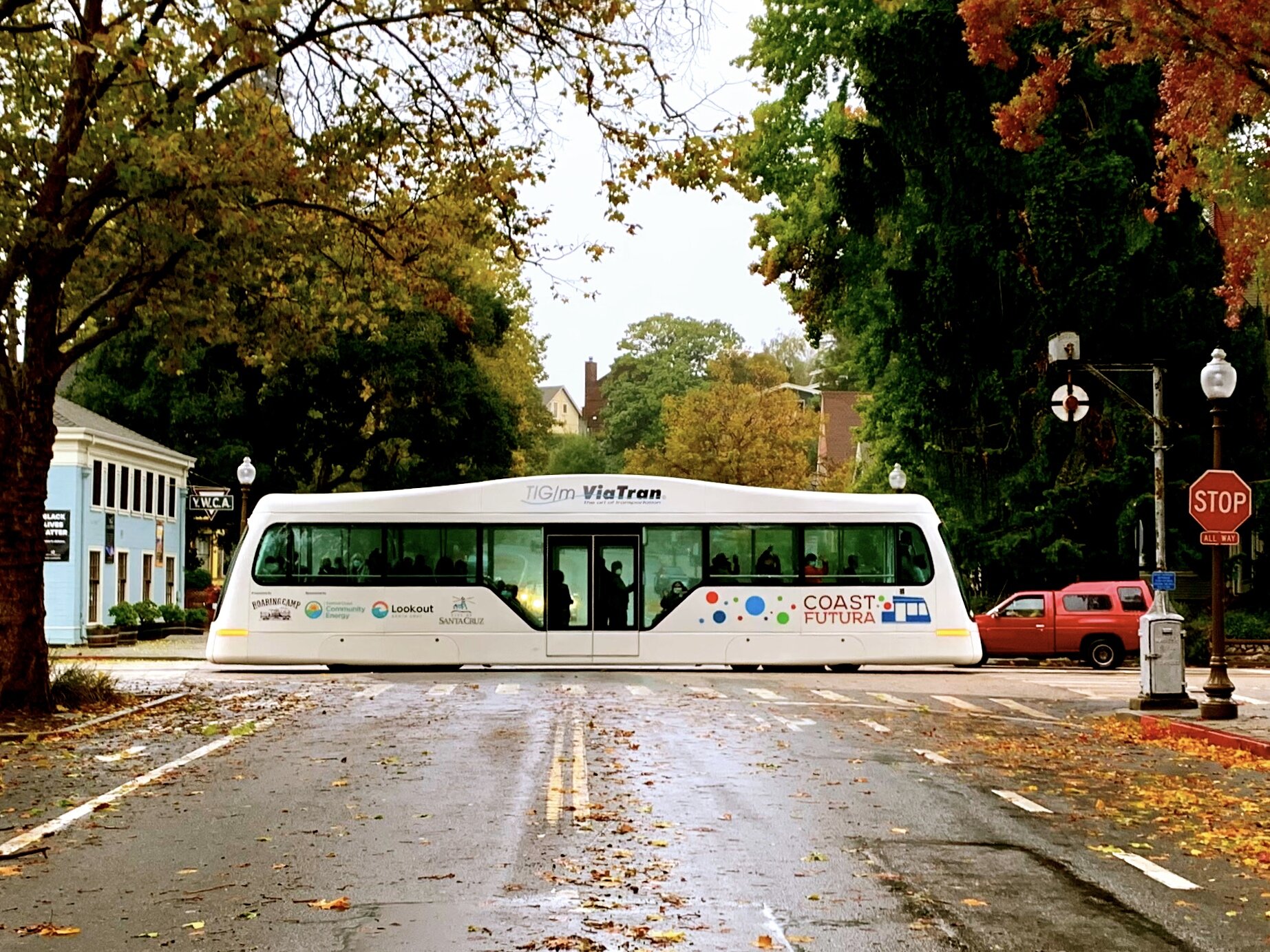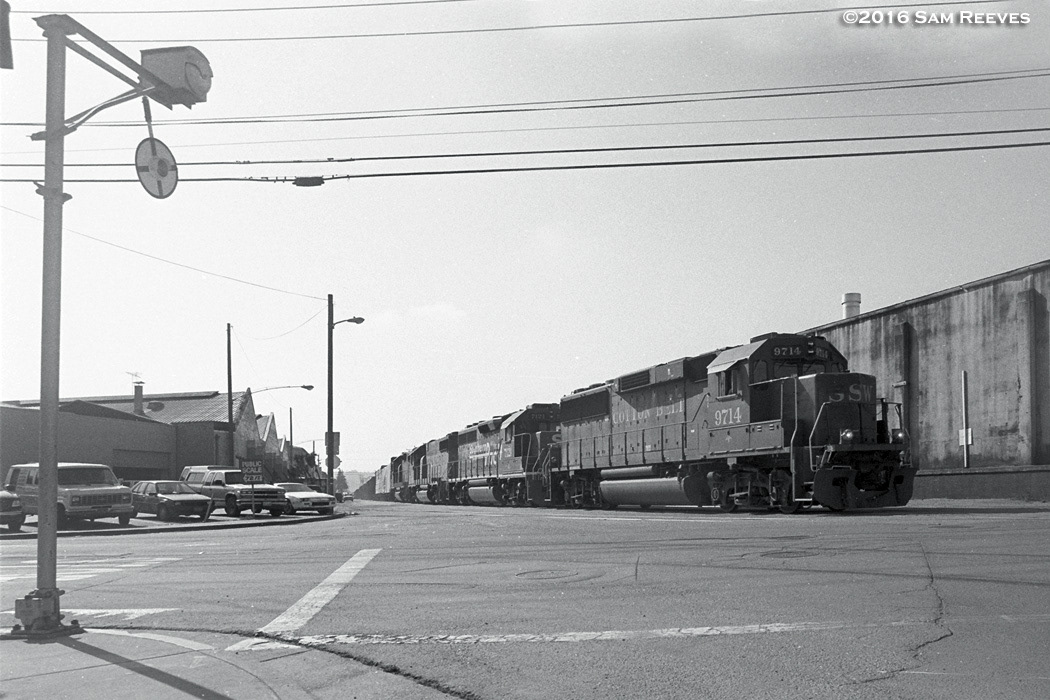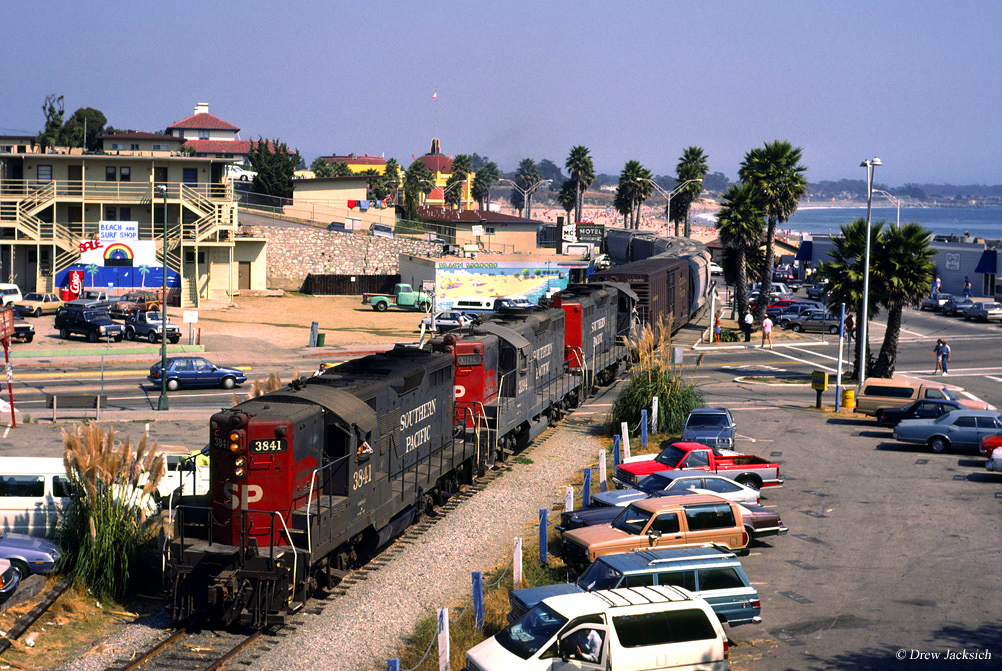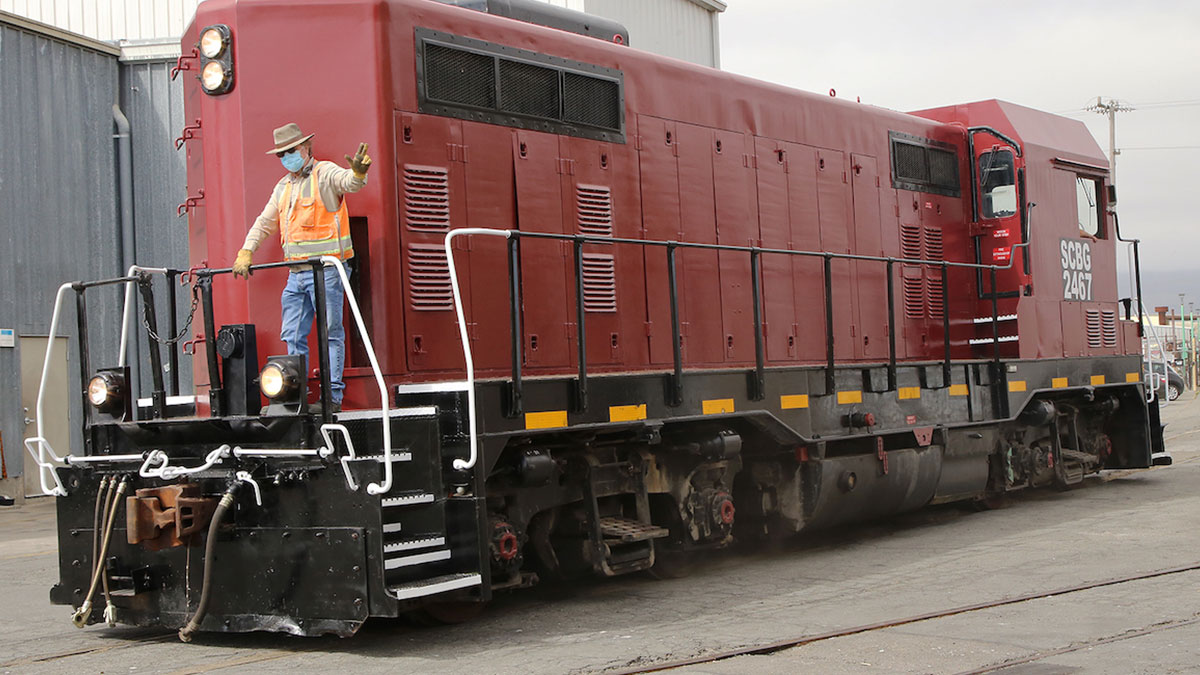On the evening of February 26, 1940, something momentous happened in Santa Cruz County. Earlier in the day, a massive rain storm had passed over the Santa Cruz Mountains causing landslides and sinks in several places along the Southern Pacific Railroad's branch line over the Santa Cruz Mountains. The evening commuter train to San Francisco could not return across the mountains so buses were brought in to collect passengers in Felton and shuttle them to Santa Cruz, where the train took them to the Bay Area via Watsonville Junction and the Coast Division mainline. Nobody knew it at the time, but this evening train was the last regularly scheduled commuter train to run in Santa Cruz County.
 |
| The Coast Futura demonstration electric trolley on Chestnut Street, October 2021. [Coast Futura] |
Over eighty years have now passed since Santa Cruz County last had regular commuter service on any of its lines. Several attempts have been made over the decades to revive service in both the mountains and along the coast, however. While the former has become increasingly unlikely as the years march on, the latter remains possible since the tracks are still in place between Watsonville Junction and Davenport. Indeed, the entire route had been in daily use as a freight line until 2010, when the Santa Cruz Portland Cement Company plant in Davenport closed, and parts of it have remained in continuous use to the present.
 |
| Southern Pacific Railroad survey photo showing storm damage in Laurel, April 9, 1940. [Bruce McGregor] |
Following the end of rail transportation across the mountains in 1940, Southern Pacific shifted to providing bus service through Pacific Greyhound. The railroad did this as a cost-saving move, but gathered support for it through lies and half-truths. In 1940, the company promised efficient commuter bus service, at same or similar prices, and the same level of support provided to rail passengers. It also resumed seasonal Sun Tan Special excursion trains, now via Watsonville Junction, to the relief of the Santa Cruz Seaside Company and many other summer businesses. Yet World War II allowed the company to reduce its services substantially and back out of many of its commitments.
 |
| Sun Tan Special at the Boardwalk, mid-1950s. [Joshua Reader] |
The end of the war marked a return of demand for passenger service. In 1946, the local railroad agent, A. L. Andrews, stated that commuter service would be made available if there were a demand for it. The Sun Tan Special returned in June 1947 to much hype and signalled a return to normalcy after the war. The service continued every summer until Labor Day 1959. Other hired excursion trains resumed too beginning in May 1947, taking visitors to the Santa Cruz Beach Boardwalk, Davenport, and Henry Cowell Redwoods State Park (Big Trees), and these continued to operate through 1965, after which all forms of passenger service were discontinued in the county and the railroad tracks were downgraded to light freight-only status.
 |
| Sun Tan Specials at the Santa Cruz freight yard awaiting a return to San Francisco, 1950s. [Jim Vail] |
These hints at passenger service did not satisfy locals, though. While seasonal tourist service enlarged Southern Pacific's coffers, locals were left only with year-round freight and undependable bus service. The local train stations, mostly servicing freight customers, continued to sell bus and rail tickets to the public, but they were poorly patronized and most were closed by the mid-1950s. A system-wide bus strike in 1952 gave hope to potential customers that commuter service would return to Santa Cruz County; however, Southern Pacific admitted that it did not have enough passenger cars to support commuter service even if it wanted to, which it did not. A 1959 Sentinel editorial outlined the plight of the railroads and how little interest Southern Pacific had shown toward maintaining any passenger service in Santa Cruz County whatsoever. From subpar passenger coaches on excursion trains to poor upkeep of the Santa Cruz Union Depot to the reduction of freight service to rural stations, the editor made it clear that Southern Pacific had failed in its duty to the county.
 |
| Southern Pacific diesel locomotive switching freight cars at the Santa Cruz yard, 1960s. [Jim Vail] |
From 1966, Southern Pacific fought any attempt to return passenger service to the county. The railroad was entirely in favor of a buy-out, though. As early as 1971, Southern Pacific expressed interest in leasing or selling Santa Cruz County's trackage to a third party. This would allow passenger service to resume, force the third party to maintain the tracks, and also allow Southern Pacific to bypass its workers' union. Unfortunately, Amtrak, which formed in 1971, was not interested in reviving passenger service since its main focus was on long-haul routes. However, in 1974, a feasibility study revealed that a revival of the Sun Tan Special could be economically feasible if enough rolling stock could be earmarked for the service. Despite strong support by State Senator Alfred Alquist, Amtrak decided against running an experimental service to Santa Cruz at this time.
 |
| The three routes assessed in the 1977 California Department of Transportation feasibility study. |
Throughout the rest of the 1970s and 1980s, Southern Pacific remained opposed to any expansion or continuation of passenger service in the Bay Area. Even local government-controlled commuter systems in the Santa Clara Valley could make no headway with the railroad. Its position was that anyone interested in reviving commuter service on its rails would have to buy or lease the route first. Proposition 5 (1974) provided state funding for local transportation initiatives, including for the maintenance of rights-of-way, purchasing of rolling stock, and supplementing of transportation income. A feasibility study conducted by the California Department of Transportation in 1977 found that restoration of commuter service along the Santa Cruz Branch was a viable option.
 |
| A Southern Pacific freight train heading south beside Davenport, 1988. [Drew Jacksich] |
Santa Cruz County Regional Transportation Commission (RTC) reports released in 1980 and 1983 also indicated the feasibility of commuter service along the Santa Cruz Branch, although it would have to be subsidized to not run at a loss. The earlier report championed daytime commuter and nighttime freight service, while the latter study found that jointly operated daytime service was preferred. The 1983 report estimated annual ridership would be 335,800 to 568,550 passengers, 75 percent of whom would be commuters. The system would use diesel trolley cars slightly larger than a bus to run 24 trips per day from 7:00am to 7:00pm. The most patronized stops would be Watsonville, Capitola, and Santa Cruz, although the proposed service would also include stops for UCSC, Aptos, Soquel, Live Oak, and the Santa Cruz Beach Boardwalk. The annual operating costs were estimated at between $343,000 to $588,000, and state subsidies could cover up to $700,000.
 |
| Southern Pacific freight train hauling ballast through Watsonville, early 1980s. [WorthPoint] |
Warren Weber, chief of rail service for Caltrans, suggested that the most viable option for the county was to buy the right-of-way. As expected, Southern Pacific balked at any suggestion that passenger service could resume on the freight-only, "Salad Bowl Express" route. The railroad insisted that any commuter service would interrupt its produce shipping schedule in Watsonville, and that freight was the only source of potential railroad revenue in the county. Opposition also came from the shippers themselves, 52% of whom stated that any change in shipping time would disrupt their service. Lastly, a vocal minority of local leaders came out against any restoration of commuter service, citing the possible fiscal deficit that could result from the service, competition with the existing public transportation network, and the long journey time of the service. The RTC decided to defer responsibility to the Santa Cruz Metropolitan Transit District (METRO) in July 1983 for them to conduct their own feasibility study.
 |
| One of the Santa Cruz Big Trees & Pacific Railway locomotives beside the Boardwalk, 1989. [ATOMIC Hot Links on Flickr] |
The earlier studies prompted the formation of the first community action group, Renaissance of the Railroad, in August 1980. Its goal was to restore seasonal excursion service to the Santa Cruz Branch by working with a private operator. The RTC supported the venture and provided limited staff resources to investigate the option. Renaissance estimated that the cost of a two-year pilot program would be $646,000. The disastrous storm of 1982 provided the county with an opportunity to act. The Olympia part of the Santa Cruz Branch was damaged in the storm and Southern Pacific was no longer interested in catering to the two remaining freight customers along the line. As a result, Norman Clark of Roaring Camp Railroads stepped in and bought the 8-mile section from Laurel Street in Santa Cruz to the end of track at Eccles north of Felton for around $2 million. In 1986, the first recreational passenger train of the Santa Cruz Big Trees & Pacific Railway ran from Felton to the Santa Cruz Union Depot. The next year, service was extended to the Santa Cruz Beach Boardwalk. The service has run seasonally ever since. Although Clark had said that he would support a commuter service along the line, no such service materialized.
 |
| A Southern Pacific freight train heading through Watsonville to the mainline at Watsonville Junction, mid-1980s. [Sam Reeves] |
Meanwhile, others worked to resolve the commuter rail impasse along the Santa Cruz Branch. Following a year of research, METRO decided unanimously to put the matter to a public vote. Measure A (1984)'s goal was to secure state funding provided by Proposition 5 for the research and development of fixed guideway public transportation systems in the county. While some of the touted ideas included a downtown-beach monorail, a Capitola to Santa Cruz streetcar line, movable walkways, and light rail, the heart of the idea was the restoration of commuter rail service. Unlike later measures, this one had the full support of all local politicians. If passed, the measure could secure around $11 million in funding from state and national agencies. On November 6, citizens voted overwhelmingly in favor of Measure A with 83% voting "yes." Commuter rail was back on the table.
 |
| Potential locations for stops of along an aerial tramway, 1989. [Santa Cruz Sentinel] |
Until June 1985, submissions were solicited by METRO to explore the range of fixed guideway systems that the county could potentially support. A federal consultant submitted a preliminary report in November that ruled that the best option for a fixed guideway system was between Pogonip or UCSC and the Boardwalk via downtown, primarily because it would provide easy transportation for tourists and would have public support. At the same time, the consultant rejected every other existing option in the county because they would conflict with existing conveyances. Frustratingly, this meant that federal funds could only be applied to an entirely new fixed guideway rather than utilizing the existing Southern Pacific right-of-way. While many options for this new route were discussed, an aerial tramway from UCSC to the Boardwalk via Harvey West Park and downtown was considered the best solution.
| The freight and passenger depot at Watsonville Junction, 1980s. [Watsonville Memories] |
The October 17, 1989 Loma Prieta Earthquake briefly led to a resurrection of commuter passenger service for Watsonville. For three weeks beginning October 23, Southern Pacific restored passenger service to Watsonville to help commuters get to the Bay Area, since many of the local roads were barely usable. Around 40 commuters used the service, with stops at Salinas, Gilroy, and Morgan Hill adding another 130 passengers. The journey to San José took about an hour. Unfortunately, the service came to an abrupt end on November 10 due to insurance and liability problems, and it was never reinstated.
 |
| A triple-header Southern Pacific freight train on its way to Davenport, 1987. [Drew Jacksich] |
Also in 1989, a second countywide report revealed that using the existing Santa Cruz Branch was by far the most logical solution for commuters. Initial estimates suggested that up to 6,000 people would use the service per day between La Selva Beach and Natural Bridges State Park, as well as between Felton and Santa Cruz. It further estimated that over 30,000 daily commuters would ride the train by 2005. The preferred means of conveyance were diesel-powered railroad cars, or railbuses, that could hold up to 100 people each. Spur lines to Cabrillo College and the Santa Cruz Metro Center were planned.
 |
| Southern Pacific freight train crossing the Manresa State Beach bridge, 1996. [Sam Reeves] |
The 1990s saw an increase in discussions regarding the feasibility of restoring commuter passenger service to the county. Proposition 116 (1990), which gave state subsidies for alternative transportation projects, passed with 60% approval in Santa Cruz County. In 1995, another feasibility study found that using the Santa Cruz Branch for commuter service was still viable. Yet the overwhelming defeat of Proposition 185 in November 1994, which would have allocated substantial funding to local rail projects, likely made any expansion of rail services in the county infeasible. Meanwhile, at the end of 1991, financial difficulties forced METRO to pass responsibility for the project back to the RTC, which formed a Fixed Guideway Oversight Committee in response. The RTC has been responsible for all county railroad projects ever since.
 |
| Staff photo from the Sentinel showing Barbara Rodak of RAILS at her home in Aptos, August 16, 1993. |
Proposition 116 and the railbus plan prompted the creation of a community action group, Community Rail Transportation, which lobbied local governments to support commuter rail. In response, another group, Aptos-based Right-of-way Alternatives In Local Suburbs (RAILS), formed to oppose any expansion of rail services and to convert the railroad right-of-way to a hiking/biking trail. Around the same time, Santa Clara County Supervisor Rod Diridon announced his support for restoring the Sun Tan Special by any means necessary, while Santa Cruz County Supervisor Gary Patton became the first loud voice against restoring passenger service. He feared that extending commuter rail service to Santa Cruz County—which he admitted would be financially viable and a generally successful idea—would turn the county into a satellite of the Silicon Valley. It was a short-sighted sentiment that was already contradicted by the reality that Santa Cruz had long been considered a part of the wider Bay Area.
 |
| The "Return of the Sun Tan Special" train at Aptos, May 18, 1996. [Aptos Museum] |
Debate continued throughout the late 1990s even as no further progress was made. In 1996, County Supervisor Walt Symons came out vocally in support of converting the Santa Cruz Branch to a hiking and biking trail, surely not the first local official to do so but one of the first to make their opinion public. By 1998, a plan was in place to purchase part of the railroad's right-of-way to build a county-wide bike path, but the California Transportation Commission rejected using Proposition 116 funds for the project. Meanwhile, pro-rail supporters finally got their long-sought return of the Sun Tan Special that year when three demonstration runs from Watsonville Junction to the Boardwalk were conducted by Amtrak and RegioSprinter. All three were successful but did not convince Union Pacific (which had taken over Southern Pacific that year) of the viability of regular or seasonal passenger service along the Santa Cruz Branch. A feasibility study conducted by the RTC in 1999 reported that commuter service would cater to no more than 5,000 daily riders, thereby making the prospect unappealing.
 |
| Official logo for Santa Cruz County Friends of the Rail & Trail. |
At the turn of the millennium, Santa Cruz County's options for restoring commuter rail were slim. After decades of research, funding applications, and public debate, the RTC's commissioners were prepared to drop the concept from its 25-year plan. But they didn't. Instead, with public encouragement and the support of the newly-formed Santa Cruz County Friends of the Rail & Trail (FORT), the commissioners dug in their heels and bought the Santa Cruz Branch from Union Pacific using all funding sources they could find. Negotiations with the railroad began in 2002 and continued for a decade. During this time, the CEMEX-owned Santa Cruz Portland Cement Company refinery in Davenport closed, ending over a century of freight traffic along the North Coast. Freight traffic along the Roaring Camp-owned Olympia Branch had also come to an unofficial end when ProBuild absorbed the San Lorenzo Lumber Company and shifted to using trucks.
 |
| First run of the Iowa Pacific train on the Santa Cruz Branch Rail Line, November 2012. [Derek Whaley] |
In 2012, the RTC finally closed escrow on the Santa Cruz Branch Rail Line (SCBRL) for a price of $14.2 million, taking heavily from Proposition 116 funds. The purchase required that the line be used for freight and passenger service. Union Pacific's contracted common carrier along the line, Sierra Northern Railway, was uninterested in providing the latter and terminated its contract. Iowa Pacific Holdings took over under the subsidiary Santa Cruz & Monterey Bay Railway and brought in a vintage diesel locomotive and consist to provide seasonal excursion service along the line. It also took over freight duties in Watsonville. For three years, things were looking bright. In 2014, a plan was completed that integrated the county's rail and rail-trail future with that of Monterey County. The next year the RTC completed a feasibility study setting out the path forward to restore commuter services in the county. And finally in 2016, the passage of Measure D allocated 25% of a sales tax increase to rail and trail projects. Yet trouble was brewing.
 |
| Official advertisement from Greenway, formerly the Great Santa Cruz Trail Study Group, 2017. [change.org] |
The end of regular freight service outside Watsonville combined with a poorly-maintained right-of-way and the gimmicky nature of Iowa Pacific's excursions added fuel to the fire of the anti-train lobby. Trail Now was formed in 2013 to promote the idea of removing the railroad tracks and building a multimodal trail. The next year, the Aptos Rail-Trail Investor Group formed to petition more formally against the restoration of rail services throughout the county. This grew into the Great Santa Cruz Trail Study Group and, ultimately, Greenway in 2017. While touting itself as a grassroots organization of like-minded local residents, in reality it is run by wealthy property investors and tech millionaires whose only formal plan is to disrupt and delay any decisions related to using the SCBRL.
 |
| A section of track suspended above a washout near Watsonville Slough, October 2017. [Derek Whaley] |
Not all problems were caused by rail opponents, though. In 2016, Iowa Pacific found itself in legal and financial trouble. It eventually announced its decision to abandon its contract in Santa Cruz County in 2017, leaving the RTC in a tough position. Around the same time, heavy winter rains caused a major washout beside Watsonville Slough, making all rail transportation impossible beyond that point except by Roaring Camp or smaller maintenance-of-way vehicles. State and federal regulators, mixed with Greenway obstacles, delayed repairs until 2019. In the meantime, Progressive Rail was brought in as the new common carrier, operating as the St. Paul & Pacific Railway, under similar conditions as its predecessor. However, those conditions were dependent on the repair and upkeep of the SCBRL, which was the responsibility of the RTC. Greenway has ensured that every obstacle possible falls in the way of the RTC performing its duties.
 |
| The Coast Futura electric trolley running alongside a section of the rail-trail, November 2021. [FORT] |
The release of the Unified Corridor Investment Study in 2019 paved the way for the RTC to finally develop the SCBRL properly. In December 2020, the first of many segments of trail opened alongside a portion of the SCBRL, with a second segment opening in July 2021. In October, a commuter demonstration Coast Futura electric trolley ran in both Watsonville and Santa Cruz to general acclaim. This coincided with the RTC staff's recommendation to adopt a similar modern electric passenger trolley as the preferred technology for use in a commuter rail system along the SCBRL.
 |
| One of the two Santa Cruz Big Trees & Pacific Railway locomotives trapped in Watsonville performing common carrier duties on behalf of Progressive Rail, May 2021. Photo by Tarmo Hannula. [Santa Cruz Good Times] |
But Greenway has continued to obstruct in whatever way possible. An influential member was elected to the Santa Cruz County Board of Supervisors in November 2020. He quickly worked to split the RTC evenly between pro- and anti-rail commissioners. The obvious impasse this would present prompted Progressive Rail to throw in the towel. It contracted out its common carrier duties to Santa Cruz Big Trees & Pacific Railways, which had bought two diesel locomotives to supplement its fleet in 2018 only for them to become stranded in Watsonville because of the RTC's failure to keep the line operable. In early 2022, the RTC proposed revoking Roaring Camp's right to operate as a common carrier along the Olympia Branch. This was part of a grander attempt by the Greenway-influenced RTC to abandon the SCBRL. When this failed, Greenway gathered signatures to put a new measure on the June 2022 primary ballot: Measure D. The measure attempted to force the RTC to abandon the SCBRL and strip all language relating to rail transit from the 20-year general plan.
 |
| Concept drawing of the Santa Cruz Branch Rail Line beside a two-lane paved trail. [FORT] |
Despite a very well funded campaign, Greenway and its Measure D lost on June 8, 2022, with the results an overwhelming endorsement for shared rail and trail usage along the SCBRL. With the status quo maintained and Greenway reeling from the defeat, it is up to the RTC, Progressive Rail, and Roaring Camp Railroads to decide Santa Cruz County's railroad future. Feasibility study after feasibility study dating to the 1970s has shown the strong potential of commuter services in the county, yet still the residents of Santa Cruz County wait for the promises of Measure A and Proposition 116 to come to fruition. Will the Sun Tan Special return? Will electric trolleys run commuters between Santa Cruz and Watsonville? Will Santa Cruz County ever rejoin the California passenger rail network? Only time can tell.
Citations & Credits:
- Santa Cruz County Friends of the Rail & Trail. "History of the Rail & Trail Project: Progress VS Obstruction." March 16, 2022.
- Various articles. Santa Cruz Evening News, Santa Cruz Sentinel-News, and Santa Cruz Sentinel.
- Weller, Jim. "Case against Greenway in Santa Cruz, or...do not support the Greenway fraud!" Bratton Online, 2021.
- Whaley, Derek R. "The End of the Line: The Abandonment of Passenger Services in Santa Cruz County, California," Railroad History 215 (Fall-Winter 2016), 12-33.
- Whaley, Derek R. Santa Cruz Trains: Railroads of the Santa Cruz Mountains. Santa Cruz, CA, 2015.

No comments:
Post a Comment
Note: Only a member of this blog may post a comment.